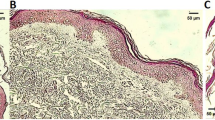Abstract
Autoimmunity and microbial agents have been suggested as playing a pathogenetic role in psoriasis. Since immune responses to microbial infections are often directed towards heat shock proteins (HSP), we investigated the expression of three HSP families in normal and inflamed human skin. Specimens from ten patients with psoriasis and three patients with positive patch tests for nickel and from five healthy volunteers were analysed by means of immunohistochemistry. The patterns observed were qualitatively similar in these conditions showing only minor quantitative differences. Psoriatic epidermis exhibited the highest level of expression. HSP27, HSP70 and heat shock cognate protein 70 (HSC70) were readily detectable. HSP27 was homogeneously distributed throghout the epidermis, whereas HSP70 was restricted to the basal layer and HSC70 primarily to the suprabasal layers. Other HSPs were detected to a lesser degree and showed a more irregular pattern. Thus, the qualitative expression pattern of HSPs seems to be constant between different skin conditions, but the expression of constitutive and inducible HSP70 depends on the differentiation state of keratinocytes.
Similar content being viewed by others
Abbreviations
- BiP :
-
immunoglobulin heavy chain binding protein
- GrP :
-
glucose regulated protein
- HSC70 :
-
heat shock cognate protein 70
- HSP :
-
heat shock protein
- HSP70 :
-
heat shock protein 70
References
Boehncke W-H, Küenzlen C, Zollner TM, Mielke V, Sterry W (1994) Predominant usage of distinct T cell receptor VΒ regions by epidermotropic T cells in psoriasis. Exp Dermatol (in press)
Chicz RM, Urban RG, Gorga JC, Vignali DAA, Lane WS, Strominger JL (1993) Specificity and promiscuity among naturally processed peptides bound to HLA-DR alleles. J Exp Med 178: 27–47
Christophers E, Sterry W (1993) Psoriasis. In: Fitzpatrick TB, Eisen AZ, Wolff K, Freedberg IM, Austen KF (eds) Dermatology in general medicine, 4th edn. McGraw Hill, New York pp 489–514
Ciocca DR, Adams DJ, Bjercke RJ, Edwards DP, McGuire WL (1982) Immunohistochemical detection of an estrogen-regulated protein by monoclonal antibodies. Cancer Res 42: 4256–4258
Cohen IR, Young DB (1991) Autoimmunity, microbial immunity and the immunological homunculus. Immunol Today 12: 105–110
Edwards DP, Weigel NL, Schrader WT, O'Malley WO, McGuire WL (1984) Structural analysis of chicken oviduct progesterone receptor using monoclonal antibodies to the subunit B protein. Biochemistry 23: 4427–4435
Flaherty KM, De Luca-Flaherty C, McKay DB (1990) Three-dimensional structure of the ATPase fragment of a 70 kDa heatshock cognate protein. Nature 346: 623–628
Ikai K, Shimizu K, Furrakawa F, Fukushima M (1991) Induction of 72-kD heat shock protein and cytoskeleton damage by cytotoxic prostaglandin 12-PGJ2 in transformed human epidermal cells in culture. J Invest Dermatol 98: 890–894
Lai BT, Chin NW, Stanek AE, Keh W, Lanks KW (1984) Quantitation and intracellular localization of the 85K heat shock protein by using monoclonal and polyclonal antibodies. Mol Cell Biol 4: 2802–2810
Lindquist S, Craig EA (1988) The heat shock proteins. Annu Rev Genet 22: 631–677
Minota S, Cameron B, Welch WJ, Winfield JB (1988) Autoantibodies to the constitutive 73-kD member of the hsp 70 family of heat shock proteins in systemic lupus erythematosus. J Exp Med 168: 1475–1480
Morhenn VB, Abel EA, Mahrle G (1982) Expression of HLA-DR antigen in skin from patients with psoriasis. J Invest Dermatol 78: 165–168
Muramatsu T, Tada H, Kobayashi N, Yamji M, Shirai T, Ohnishi T (1992) Induction of the 72-kD heat shock protein in organcultured normal human skin. J Invest Dermatol 98: 786–790
Noah PW (1990) The role of microorganisms in psoriasis. Semin Dermatol 9: 269–276
Palleros DR, Welch WJ, Fink AL (1991) Interaction of hsp 70 with unfolded proteins: effects of temperature and nucleotides on the kinetics of binding. Proc Natl Acad Sci USA 88: 5719–5723
Rambukkana A, Das PK, Krieg S, Yong S, Le Poole IC, Bos JD (1992) Mycobacterial 65,000 MW heat-shock protein shares a carboxy-terminal epitope with human epidermal cytokeratin 1/2. Immunology 77: 267–276
Rambukkana A, Das PK, Witkamp L, Young S, Meinardi MMHM, Bos JD (1993) Antibodies to mycobacterial 65-kDa heat shock protein and other immunodominant antigens in patients with psoriasis. J Invest Dermatol 100: 87–92
Rook GAW, Standford JL (1990) Slow bacterial infections or autoimmunity? Immunol Today 13: 160–164
Rosenberg EW, Noah PW, Skinner RB Jr, Swaag R van der, West SK, Browder JF (1989) Microbial association of 167 patients with psoriasis. Acta Derm Venereol Suppl (Stockh) 146: 72–76
Sauchez ER, Meshinchi S, Tienrungroj W (1987) Relationship of the 90-kDa murine heat shock protein to the untransformed and transformed states of the L cell glucocorticoid receptor. J Biol Chem 262: 6989–6991
Schmitt-Egenolf M, Boehncke W-H, Eiermann TH, Sterry W (1993) Oligonucleotide typing reveals association of type I psoriasis with the HLA-DRB1*0701/2, -DQA1*0201, -DQB1*0303 extended haplotype. J Invest Dermatol 100: 749–752
Trautinger F, Trautinger I, Kindas-Mügge I, Metze D, Luger TA (1993) Human kerationcytes in vivo and in vitro constitutively express the 72-kD heat shock protein. J Invest Dermatol 101: 334–338
Vaux D, Tooze J, Fuller S (1990) Identification by anti-idiotype antibodies of an intracellular membrane protein that recognizes a mammalian endoplasmic reticulum retention signal. Nature 345: 495–502
Welch WJ, Feramisco JR (1984) Nuclear and nucleolar localization of the 72,000-dalton heat shock protein in heat-shocked mammalian cells. J Biol Chem 259: 4501–4513
Welch WJ, Suhan JP (1986) Cellular and biochemical events in mammalian cells during and after recovery from physiological stress. J Cell Biol 103: 2035–2052
Author information
Authors and Affiliations
Rights and permissions
About this article
Cite this article
Boehncke, W.H., Dahlke, A., Zollner, T.M. et al. Differential expression of heat shock protein 70 (HSP70) and heat shock cognate protein 70 (HSC70) in human epidermis. Arch Dermatol Res 287, 68–71 (1994). https://doi.org/10.1007/BF00370721
Received:
Issue Date:
DOI: https://doi.org/10.1007/BF00370721




